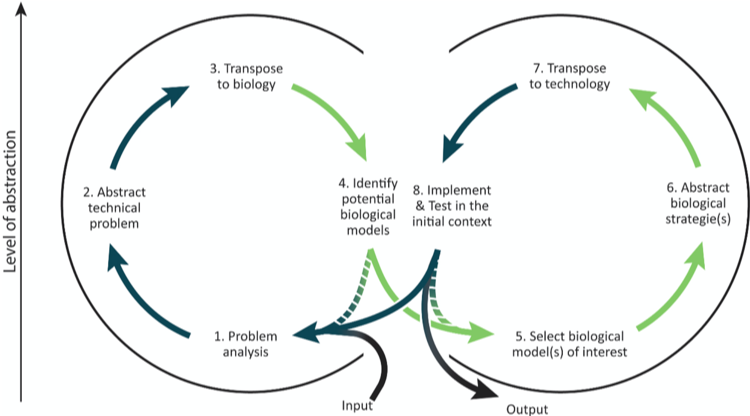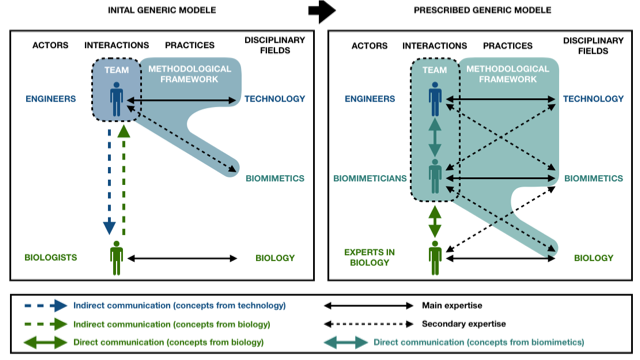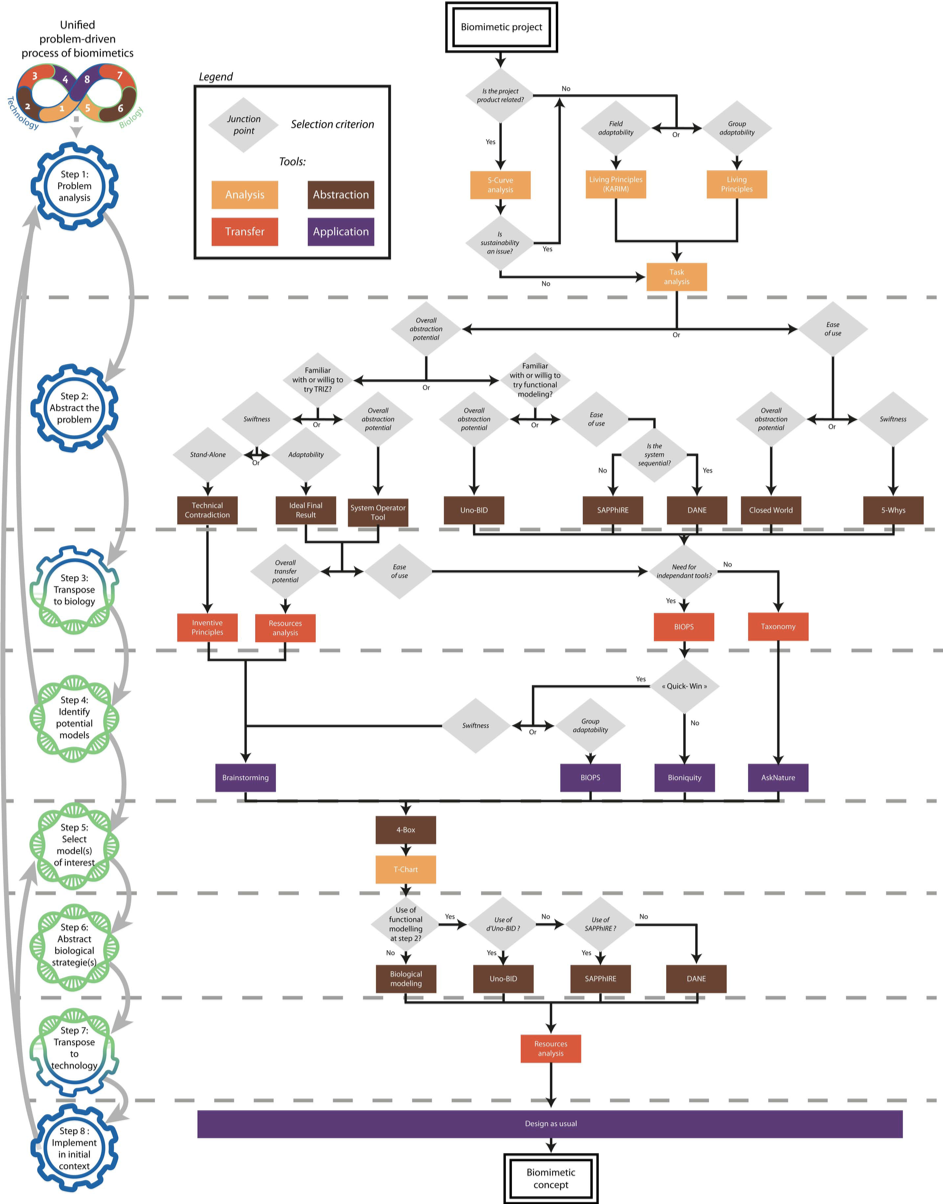Lab's research axes on biomimetics
Introduction
As a research laboratory specialized on engineering design, our team studies bio-inspiration from a methodological perspective (i.e. biomimetics) taking two fundamentally related axes into consideration:
- The process-based axis aims at the global formalization of the design process in order to better understand and optimize it.
- The profession-based axis aims at enriching the design process by integrating new knowledge, rules and tools (design, ergonomics, engineering, biology, etc.). For more clarity, this axis will be sub-divided into two categories, the studies about biomimetic tools and about the composition of biomimetic design teams.
As a recently formalized field, and in spite of clear progresses from the scientific community on the subject, biomimetics still lacks some key methodological and theoretical elements to be considered as a standardized approach. Besides, it tends to take time for progresses from research to spread to the practical side of the field, which leads to only a few implementations of scientific findings in the practical design community.
Facing this situation, our interdisciplinary research team approaches biomimetics with two objectives, to contribute to the advance of the theory of biomimetics and to make our scientific findings available to practitioners.
Research on the process-based axis
The initial target of the scientific community was to define a biomimetic process to follow. In other word, answering the question: What are the steps to follow to perform a biomimetic design ?
It has been quickly determined that biomimetics could be tackled following two types of approaches. Either the design phase occurs after a biological discovery: the biology push approach [ISO/TC266, 2015], or biomimetics is used as a problem-solving process: the technology pull approach [ISO/TC266, 2015]. As problem-solving appears at the core of engineering design in industry, we mostly investigate the technology pull approach.
With the emerging interest for biomimetics, a great number of processes have been designed to help implement such a technology pull approach [Fayemi et al., 2014].
Facing this diversity, our team first focused on comparing the published articles to abstract the common key steps composing these processes. Overall, eight main steps were identified and organized in what was then named the unified technology pull biomimetic process [Fayemi et al., 2017]. (Figure 1).

Figure 1. The unified technology pull biomimetic process (from Fayemi et al., 2017)
From a research standpoint, this process allowed most researchers to agree on a unified process to considere as a foundation for further studies. The next step in our research was then to adapt this process to practitioners' needs and to make it explicit for companies’ decision-makers.
Through experimental feedback, surveys and studies on the difficulties faced by practitioners when trying to apply the process, various optimization were proposed to turn this scientific process into a process suitable for practice [Graeff et al., 2019a] [Graeff, 2020a]. (Figure 2).

Figure 2. The technology pull interdisciplinary biomimetic process (from Graeff, 2020a)
Our current studies are then focusing on the testing phase of these new theoretical contributions with the permanent aim of allowing the improvement of biomimetic practice and so supporting its spreading.
Research on the profession-based axis
Biomimetic design teams
Research on how to perform biomimetics initially focused on making biological data available to “classic design teams” (designer, engineers, ergonomists, etc.). This initial objective anchored the idea that “classic design team” would perform biomimetics as a foundation for all further research. Because of it, the collaboration with people from biology was often overlooked and considered as a problem rather than a solution. Biologists were thus initially replaced by tools and processes were designed without considering the variety of profiles that should be involved.
Facing biomimetic lack of efficiency in practice and its current struggle to spread, several scientific articles recently start questioning this initial foundation and suggest that biologists should be further integrated in biomimetics. Even though the change of perspective had thus been initiated, only very few papers actually dealt with this research axis.
In this context, our team tackled the problem at its source by starting to study the legitimacy of integrating biologists during biomimetic design project [Graeff et al., 2018a] or [Graeff et al., 2019b], and the question of who do we call “a biologist” in a biomimetic design process was raised. These studies led to the description of the concepts of horizontal and vertical biologists [Fayemi et al., 2015] [Graeff et al., 2018b] [Graeff et al., 2019a] .
In the same time, other members of our research team focused on the use of artistic design tools and know-how as ways of transferring information between scientific sciences in the context of biomimetics [Letard et al., 2018].
All together, these studies have led us to consider the need for a new actor combining certain skills from artistic design [Letard et al., 2020]. with skills from biology [Graeff et al., 2020b]. The definition of this new transdisciplinary profile called the “Biomimetician” thus represent the synthesis of these studies. [Graeff, 2020a] (Figure 3).

Figure 3. Integration of the biomimetician (from Graeff, 2020a)
Along with this definition, the integration of this new profile within the design team and during the biomimetic process was also formalized as shown in figure 2.
Facing the numerous research axis associated with this “biomimetician”, such as the need for further characterization and for the implementation of training, investigation on this new actor remains a vast subject to explore and currently one of our top priority.
Biomimetic tools
In parallel with the processes’ development, the scientific community also focused on developing tools to perform the various steps composing the biomimetic processes.
However, as often inbengineering design, the increasing number of tools leads the user into an unclear path as it becomes more and more complicated to choose which tool to use, and under which conditions.
Through an international collaboration, our research team was involved in the comparison and characterization of available tools used in biomimetics [Wanieck et al., 2017]. Based on these results, we designed a decision tree, the BiomimeTree [Fayemi et al., 2017], leading users to choose relevant tools for their specific use (Figure 4).

Figure 4. The BiomimeTree tool (from Fayemi et al., 2017)
Additionally to this decision-making tool, several other tools were also designed by the team to deal with one of biomimetic teams’ main problem: the difficulty of interdisciplinary work.
First, the tool BABELE, which aims at helping design teams to model and select biological systems of interest. [Fayemi et al., 2015]. Then, facing the increasing need for biologists’ integration during biomimetic practice the crucial impediment of interdisciplinary communication soon emerged [Graeff et al., 2019a] Tackling this issue, we first focused on the underlining theoretical aspects to generate a shared cognitive framework and identify missing specific spaces of expression for profile having a background in biology [Graeff et al., 2020c)].
The need for an easy access and for guidance on these theoretical progresses led us to design LINKAGE (www.linkage-lcpi.com) as an embodiment of this theoretical work.
Our current studies on LINKAGE are then focusing on the gathering of experimental data to give feedback on the tool and to improve its functionalities to further support biomimetic design team during their practice [Graeff et al., 2021)]. .
Finally, as the integration of a new profile having a training in biology is one of our main axis of research, we are also working on the integration of biological tools. On this research axis, our team is currently working on the theoretical foundation that will lead to optimize the biological tools for specific biomimetic purposes.
References
See Scientific
publications for more
- ISO/TC266 2015 "Biomimétique - Terminologie, concepts et méthodologie"
- Fayemi P-E, Maranzana N, Aoussat A and Bersano G, 2014. "Bio-inspired design characterisation and its links with problem solving tools", International Design Conference, DESIGN vol 2014 (Dubrovnik) pp 173–82
- Fayemi P-E, Wanieck K, Zollfrank C, Maranzana N and Aoussat A, 2017. "Biomimetics: Process, tools and practice", Bioinspiration and Biomimetics
- Graeff E, Maranzana N and Aoussat A, 2019a. "Engineers’ and Biologists’ Roles during Biomimetic Design Processes, Towards a Methodological Symbiosis", Int. Conf. Eng. Des. ICED vol 1 (Delft) 319–28
- Graeff E, 2020a. "Innovation bio-inspirée : Modélisation d'un processus interdisciplinaire de conception biomimétique outillé et intégration d'un nouvel acteur, le Biomiméticien.", PhD Thesis, LCPI, ENSAM, Paris, France
- Graeff E, Maranzana N and Aoussat A, 2018a. "Conception biomimétique : quels acteurs pour quelles attentes ?", 18' CONFERE conference 289–310
- Graeff E, Maranzana N and Aoussat A, 2019b. "Biomimetics, where are the biologists?", J. Eng. Des. 30
- Wanieck K, Fayemi P E, Maranzana N, Zollfrank C and Jacobs S R, 2017. "Biomimetics and its tools", Bioinspired, Biomim. Nanobiomaterials 6 53–66
- Fayemi P-E, Maranzana N, Aoussat A, Chekchak T and Bersano G, 2015. "Modeling biological systems to facilitate their selection during a bio-inspired design process" International Conference on Engineering Design, ICED vol 2 (Milan) pp 225–34
- Graeff E, Maranzana N and Aoussat A, 2018b. "Role of biologists in biomimetic design processes: Preliminary results" International Design Conference, DESIGN vol 3 2018 (Dubrovnik) pp 1149–60
- Letard A, Maranzana N, Raskin K and Aoussat, 2018. "Design et biomimétisme : Quel rôle pour le designer ?" CONFERE '18 conference
- Letard A, Graeff E, Maranzana N, Raskin K and Aoussat, 2020. "How do designers impact the biomimetic concepts typology?" Conference: 22nd International Conference on Engineering and Product Design Education (E&PDE'20), Herning, Denmark
- Wanieck K, Fayemi P E, Maranzana N, Zollfrank C and Jacobs S R, 2017. "Biomimetics and its tools", Bioinspired, Biomim. Nanobiomaterials 6 53–66
- Graeff E, Maranzana N and Aoussat A, 2020b. "Biological Practices and Fields, Missing Pieces of the Biomimetics’ Methodological Puzzle" Biomimetics 2020, 5(4), 62; DOI: 10.3390/biomimetics5040062
- Graeff E, Maranzana N and Aoussat A, 2020c. "A shared framework of reference, a first step towards engineers' and biologists' synergic reasoning in biomimetic design teams" Journal of Mechanical Design, DOI: 10.1115/1.4047905.
- Graeff E, Maranzana N and Aoussat A, 2021. "LINKAGE, an online tool to support interdisciplinary biomimetic design teams" Journal of Mechanical Design, DOI: 10.1115/1.4049969.
 LINKAGE
LINKAGE 